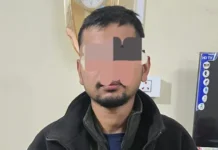Monday Musing
[ Tongam Rina ]
Once, Itanagar was a beautiful town with trees on both sides of the roads, a two-lane road that had potholes but did not disappear when the monsoon came, small wooden shops, rare concrete structures, beautiful government bungalows, traditional homes that looked like homes in the villages within the township, rundown buses that barely made it up the hill, small social forestry gardens all over the town, little waterfalls, clean streams, and untouched rivers.
Then greed took over. Beautiful government bungalows were encroached upon and dismantled to make way for tall, ugly private buildings. There was no shame in seizing government property. Who seized it? The very people in the government who were supposed to protect it. As it happened, the administration and the government turned a blind eye. Within four decades, Itanagar became a town captured by greed.
The takeover was rampant and swift. Once one person started, it became the norm for everyone to grab all they could. Itanagar and its twin city Naharlagun were once beautiful towns that belonged to everyone; now, it belongs to no one. Itanagar was planned, but the government and the administration unplanned it. How? If action had been taken the first time a government bungalow was encroached upon, we might not have been in this situation today, where everyone lives in fear because an hour of heavy rain could destroy the town. Accountability was and is nonexistent. Merely issuing orders won’t suffice; there must be follow-up. Four-lane roads were built, offering opportunities for profit. These highways lack drainage systems. Where will the rainwater go? It will obviously flood homes. Where will the streams, buried in concrete, go? Didn’t our elders tell us that water always finds its way, even when buried? Mutilated streams and rivers return to reclaim the town each monsoon.
Each year, hundreds are forced to relocate from vulnerable areas, and dozens of lives have been lost due to landslides and slush. The day is not far when tragedy will strike on a larger scale. Are we waiting for tragic consequences while the government continues to sleep, viewing yearly damages as opportunities to profit from flood relief?
What is the solution now? How can we plan a town that has no space left free from concrete? Is there a way to allow streams and rivers to flow freely again? Will anyone in the administration consider ways to ensure that rainwater can flow unimpeded?
Drainage in the town needs serious attention. In hill towns, road construction often leads to congestion. This has also happened in Itanagar. Every monsoon, the story repeats itself: roads become streams, streams turn into sewage, and encroached rivers and streams reclaim their path, destroying everything in their way.
With erratic weather patterns due to climate change worldwide, the government must wake up and prepare a foolproof monsoon readiness plan. The weather in the state swings between extreme heat and rain. Is the government planning to find solutions, or will it leave the citizens to fend for themselves?
We all recognise the problem, but where is the solution? Look around Itanagar, and all one feels is helplessness and anger at the lack of governance, action, and political will.
In the media, it was widely reported that on 23 June, there was a cloudburst in the Itanagar Capital Region. However, according to the India Meteorological Department (IMD), a cloudburst is defined as when there is 100 mm of rainfall in an hour or 50 mm in 30 minutes. As per a report by the state’s disaster management department, citing IMD records, the rainfall recorded on 23 June, which destroyed the township, was 40 mm between 10:30 am and 12:30 pm. A mere two hours of rain brought the entire capital region to its knees, exposing the inefficiency of the government and its inept administration.
Blaming citizens for the state and the capital administration’s failure to enforce rules is a clear sign of governance failure.
One basic question: why do most commercial establishments and housing complexes lack mandatory parking and drainage?
Will the Itanagar Municipal Corporation (IMC) and the capital administration at least begin clearing clogged drains after the current monsoon ends and before the next one begins? That should not be much of hard work as the drainage network in the township is almost nonexistent.
At the same time, the administration and the IMC must work in cohesion to stop earth-cutting and encroachment on the water bodies.
The administration should do its job instead of merely issuing bans or unfairly targeting the poor by evicting them first. The secretariat should be the first fined for flooding a portion of the highway, with a few floors dismantled for violating building laws. The secretariat area is flooded, and more than once, the concrete wall has fallen.
Soon, we will forget what the monsoon brought.
In winter, the land settles, the constricted river flows calmly, and everyone enjoys picnics near the rivers and streams and forgets about the floods and misery it brings to the people.






